GENED 1158 Midterm
1/93
There's no tags or description
Looks like no tags are added yet.
Name | Mastery | Learn | Test | Matching | Spaced |
|---|
No study sessions yet.
94 Terms
convection
Heat transfer process
Best in fluids
Warmer part of the mass will rise and the cooler portions will sink
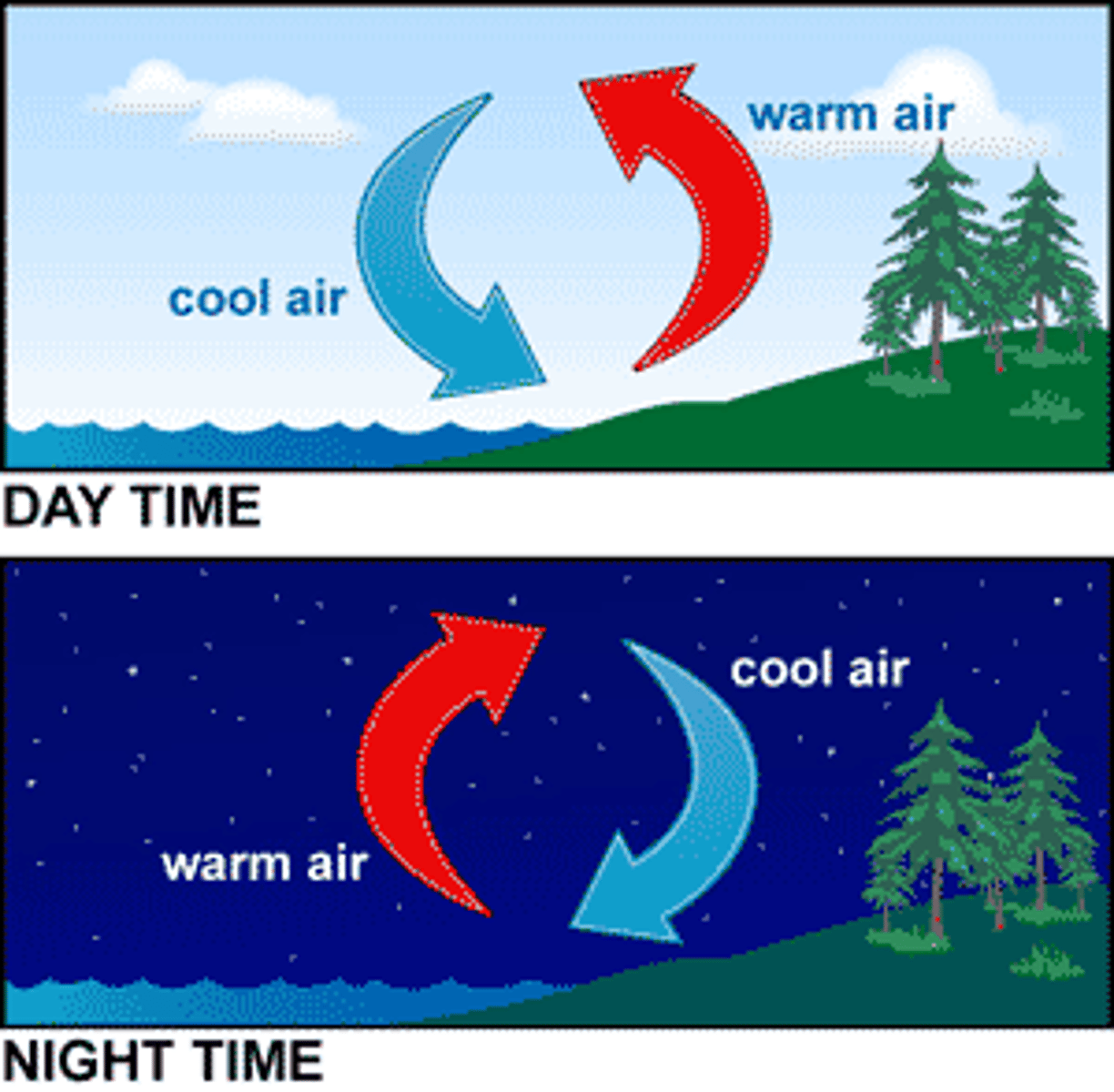
Conduction
The direct transfer of heat from one substance to another substance that it is touching. Through vibration of particles.

Global hydrological cycle
The continuous transfer of water between land, atmosphere and oceans. The Earth is a closed system.
The ocean has greater evaporation rates than precipitation so there is a surplus of water in the atmosphere which is then blown to the land surface. Conversely, the land has more precipitation than it does evapotranspiration. The water thus has to go somewhere. This is called runoff or discharge, the flow of water on or inside the land surface back into the sea.
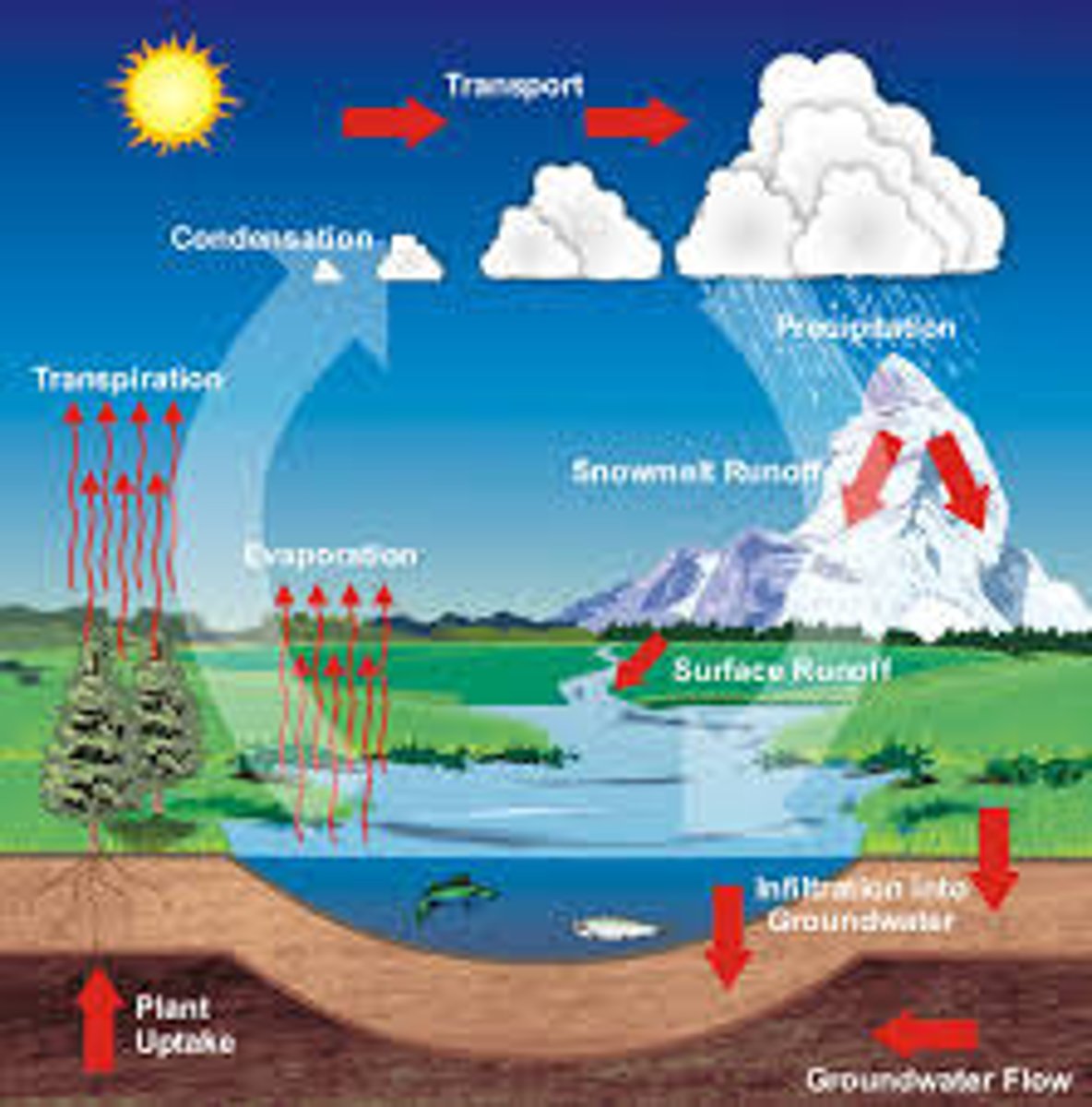
Unique properties of water
- high latent heat content (energy required when water changes phase)
- Can change phase for typical conditions on Earth
- Very high heat capacity (the amount of energy you need to change water temperature)
mass balance
Given some region (control volume):
the change in water stored in control volume
water in - water out
Watershed mass balance
Watershed: set of all points (upstream) that would ultimately route water to the defined outlet point.
A wisely chosen control volume that makes estimating storages in that control volume easier.
Convenient definition because, apart from evapotranspiration, all lateral fluxes occur at a single point, which can be measured.
residence time formula

temperature
temperature is an indirect measurement of the average kinetic energy of molecules constituting air.
High temp: high kinetic energy
Low temp: low kinetic energy
Conservation of Energy
Total energy of a system remains constant, if we account for gains and losses of energy from and to the outside.
Energy cannot be created or destroyed
Energy can be transferred or transformed into different types of energy inside the system:
- Potential energy
- Kinetic energy
- Chemical energy
- Radiative energy
What is pressure?
Indirect measurement of how much molecules in the air bump into each other
Force per unit area
Units:
How to increase pressure?
Increase the number of molecules in the air parcel
Decrease the volume of the air parcel
Increase the temperature of the air parcel
Ideal Gas Law
PV=nRT
What happens to pressure when you increase in height?
Pressure decreases with height
Conservation of momentum
What happens to temperature as you increase in height?
Up to tropopause: decreases with height
Tropopause to stratopause: increases with height
Stratopause until menopause: decreases with height
Menopause and up: increases with height
Radiation fundamentally dictates the temperature.
dynamic equilibrium
condition of continuous, random movement of particles but no overall change in concentration of materials

Atmospheric thermodynamics
the study of heat-to-work transformations (and their reverse) that take place in the earth's atmosphere and manifest as weather or climate
conduction
Transfer of heat by transfer of molecular vibrations
Most efficient in solids
Not very efficient in air. Only plays an important role in heating air very close to the surface
Molecules remain in the same place but vibrate
convection
Cooler, denser air parcels sink while warmer, lighter air parcels rise
Most efficient in fluids
Dominating heat transfer process in the atmosphere
radiation
Vibration of molecules creates an electromagnetic field, and the emission of electromagnetic radiation.
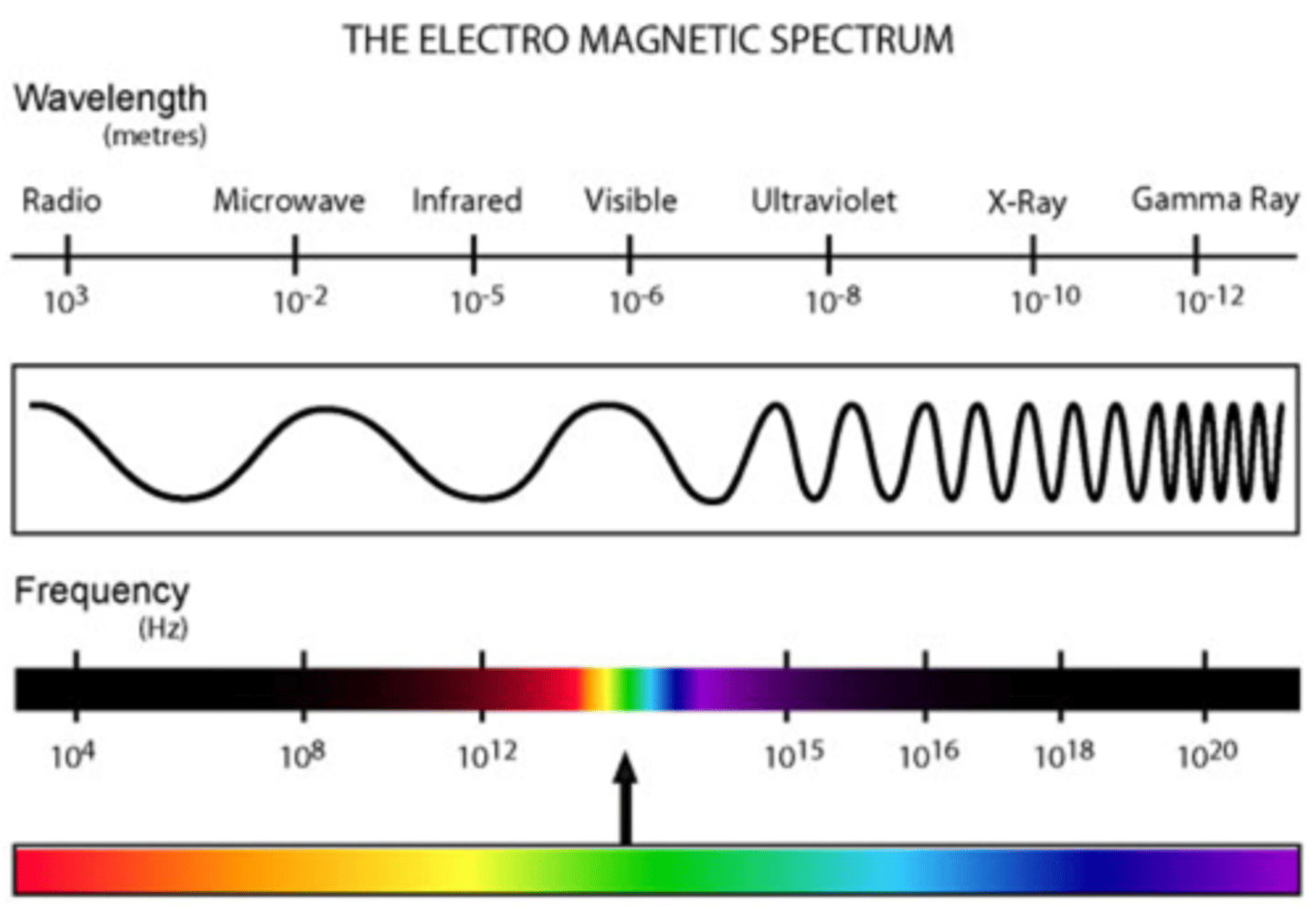
When radiation interacts with the atmosphere it can be:
Transmitted
Emission
Absorbed
Reflected or scattered
albedo
Ability of a surface to reflect light
Greenhouse Effect
warming that results when solar radiation is trapped by the atmosphere
variability in radiation
The emission of infrared radiation by Earth is relatively uniform around the globe, while the absorption of visible radiation from the sun is greater at low latitude that at the poles.
Differences in albedo
Ex: beach ball with a flash light shining on it
There is an energy surplus at the equator and an energy deficit at the poles
Positive feedback loops
Example: Ice-albedo feedback
If ice melts, more will start melting! This is bad for the melting glaciers in the poles.
negative feedback loops
Plancks feedback
temperature increases -> earth emits more infrared radiation -> earth loses energy -> temperature decreases
Seasonal variation
The reason this is experienced is because as it tilts the sun has a different angle coming into the atmosphere and thus different levels of radiation are absorbed.
Diurnal variation
Earth's rotation causes surface temperature fluctuations throughout the day and night.
When does peak temperature occur:
The peak in temperate does not occur at the same time as peak radiation, it is somewhat after
What are four ways land and oceans are different in terms of radiation?
Land has lower heat capacity than water, so land will increase in temperature more than the ocean
Energy can be mixed better through convection (over ocean) than by conduction (over land)
Solar radiation penetrates deeper through water, whereas this does not occur on land because it is opaque
Over the ocean there is unlimited water, much of the energy that is absorbed in the ocean can be evaporated whereas water on land surfaces is less capable of cooling because of evaporation.
Water phase changes
solid, liquid, gas
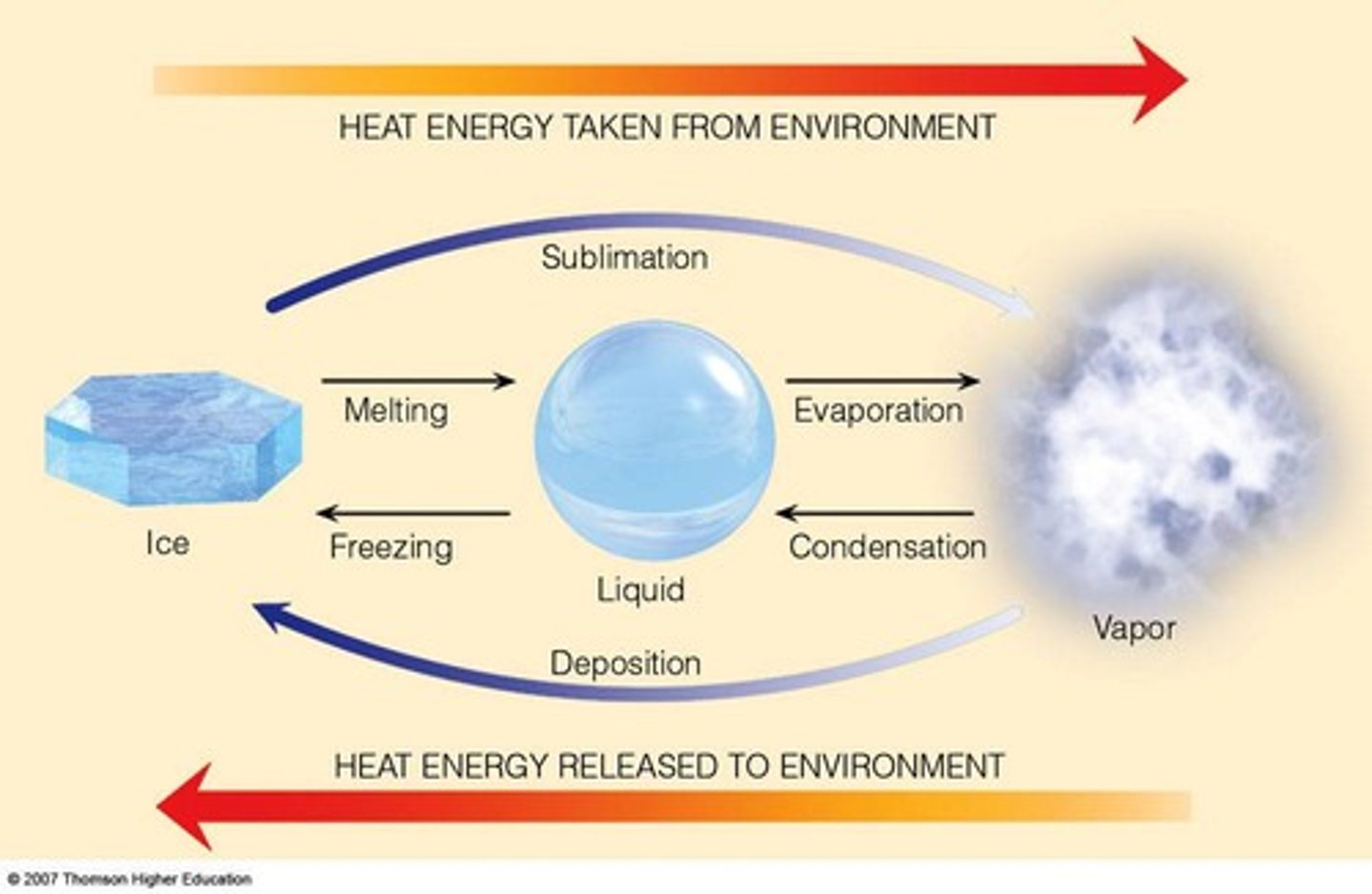
saturation
Air is saturated when evaporation balances condensation
The amount of water that can be held is a function of the temperature of the parcel.
If the parcel is hotter it can hold more water than if it was colder.
humidity
amount of water vapor in the air
absolute humidity
mass of water vapor per volume of air
specific humidity (q)
mass of water vapor per mass of air
Typical values:
q: 0-20 g/kg
mixing ratio
mass of water vapor per mass of “dry” air
Water vapor pressure (e)
pressure exerted in a given volume by water vapor alone, as if all other gases were removed from that volume.
Typical values:
e: 0-3 kPA
Relative Humidity (RH)
the amount of water vapor present in air expressed as a percentage of the amount needed for saturation at the same temperature.

Condensation
The change of state from a gas to a liquid
Dew Point temperature (Td)
A measure of humidity in disguise.
Td = the temperature you would need to decrease a parcel of air for it to saturate.
dew point depression
the difference between the actual temperature and the dew point temperature (T-Td)
Small dew point depression = air is moist
Large dew point depression = air is dry
Dew point temperature cannot be greater than the temperature. It's always less than or equal to the temp.
Diabatically
heat is exchanged with the environment (e.g., radiation cooling)
Adiabatically
no heat is exchanged with the environment (e.g. rising air)
How to saturate an air parcel?
Add more water vapor (ex: evaporation fog)
Reducing temperature (either diabatically or adiabatically)
pressure gradient force
Drives air from areas of higher barometric pressure to areas of lower barometric pressure, causing winds.
sea breeze
Flow of cooler air from over an ocean or lake toward land
Example of: pressure gradient force
land breeze
movement of air from land to sea at night
created when cooler, denser air from the land forces up warmer air over the sea
example of: Pressure gradient force
Why do winds often not blow from high to low pressure (as dictated by the pressure gradient force in the atmosphere)?
They blow orthogonal due to the Coriolis force.
Coriolis Force
The apparent force, resulting from the rotation of the Earth, that deflects air or water movement
Example: Mary-go-round
Objects in motion in the northern hemisphere are deflected at a right angle and to the right of the direction of motion
Opposite occurs in the southern hemisphere
The Coriolis force is zero at the equator, and increases with latitude, reaching a maximum at the poles.
The Coriolis force is proportional to the wind speed: faster winds lead to stronger deflection.
Since the Coriolis force is perpendicular to the wind direction, it only affects the wind direction and does not affect the wind speed: it makes the wind veer, but does not accelerate or decelerate it.
geostrophic wind
A wind that moves parallel to the isobars as a result of the balance between the pressure gradient force and the Coriolis effect
High pressure: blow clockwise (in northern hemisphere)
Low pressure: blow counterclockwise (in northern hemisphere)
To identify the direction the winds are blowing:
Identity PGF
COR balances PGF so points in opposite direction
COR points 90 degrees to the right of the wind direction.
What are summers like in West vs. East USA and why?
West: Pacific high moves cool, dry air down the west coast
East: Bermuda high brings warm, moist air from the tropics toward Florida and the east coast
The Sahel
The location of the solar maximum varies with the season and the relative position of the Earth to the sun. In the Northern Hemisphere in winter, the sun is slightly south of the equator. In the N. Hemisphere in the summer, the sun is slightly north of the equator. This means a subtle migration of the sun in the winter and summer.
This subtle change is really important to the sahel region of Africa.
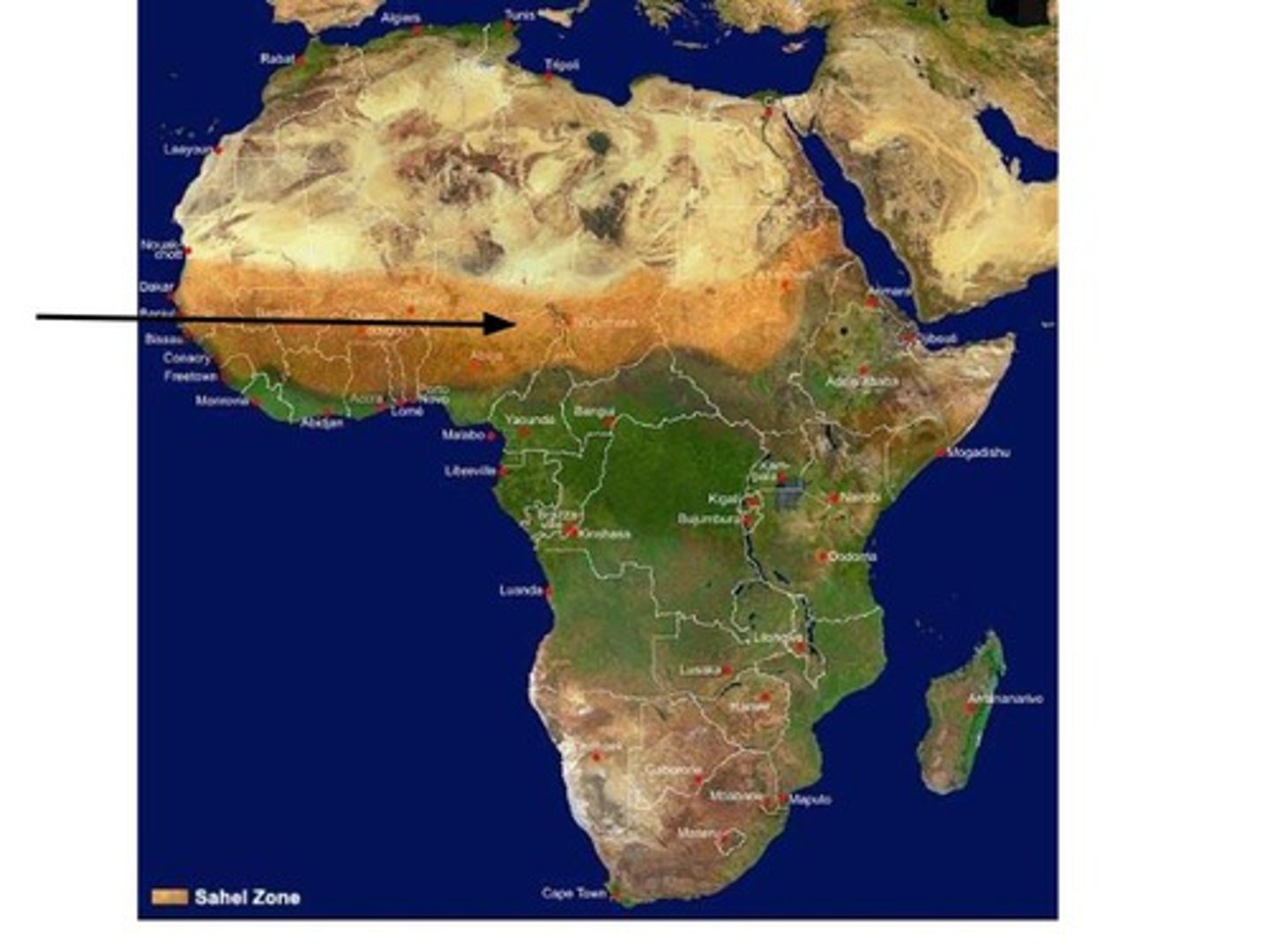
Thermodynamics of cloud formation
Cloud cool via adiabatic cooling
As the air parcel rises:
Pressure decreases
Parcel of air expands, doing work on the surrounding atmosphere
This uses up energy in the parcel, resulting in a decrease in temperature ("adiabatic cooling")
lifting condensation level (LCL)
Height at which parcel becomes saturated after being lifted adiabatically from the surface
large-scale horizontal convergence
Uplift occurs because bodies of air with similar proportions collide and move upward
Convergence of air with similar thermal properties
Frontal convergence
convergence of air with different thermal properties
Orographic uplift
Uplift that occurs when a flowing body of air encounters a mountain range.
Rain falls on one side but not the other

Adiabatic cooling occurs at a rate of:
10*K/km
cloud microphysics
Condensation
Liquid water droplets form raindrops
Potential barriers: evaporation, updrafts
homogeneous nucleation
As air becomes supersaturated, molecules of liquid water combine to form droplets.
However, this process is very inefficient—requiring extremely high levels of supersaturation.
Heterogeneous nucleation
the addition of cloud condensation nuclei helps droplets to grow
cloud condensation nuclei
small airborne particles upon which water vapor condenses to form clouds and rain
Ways to measure rain
standard rain gauge
radar (horizontally, bounces off rain)
satellite (senses T of cloud)
Thermal convection
If a parcel is in an area where the surrounding air is colder than the parcel, it floats.
When do floods occur
When the rate of rain exceeds the capacity of a land surface to absorb the rain (infiltration capacity).
Infiltration capacity
The maximum rate at which rain can be absorbed by a soil in a given condition
Infiltration rates vary by soil type. Sand has large granules so water is absorbed more effectively than clay or cements which is almost 0 absorption.
Why do hurricanes mostly occur in the North Atlantic and West Pacific?
Hurricanes rarely form in SouthAtlantic and Eastern South Pacific because there water is too cold & at the equator there is no Coriolis.force.
Why do hurricanes move east to west?
Hurricanes form near the equator where the water is warm
Easterly winds push these hurricanes east
They begin to shift west when they hit the westerly winds
Why no hurricanes at the equator?
Wind blows parallel to isobars, with higher pressures on the right (in the northern hemisphere)
Wind speed is proportional to the pressure gradient (i.e., the tightness of the isobars)
Winds tend to blow clockwise around highs, and counterclockwise around lows
natural levee
results from continual flooding
a deposit of sand or mud built up along, and sloping away from, either side of the flood plain of a river or stream
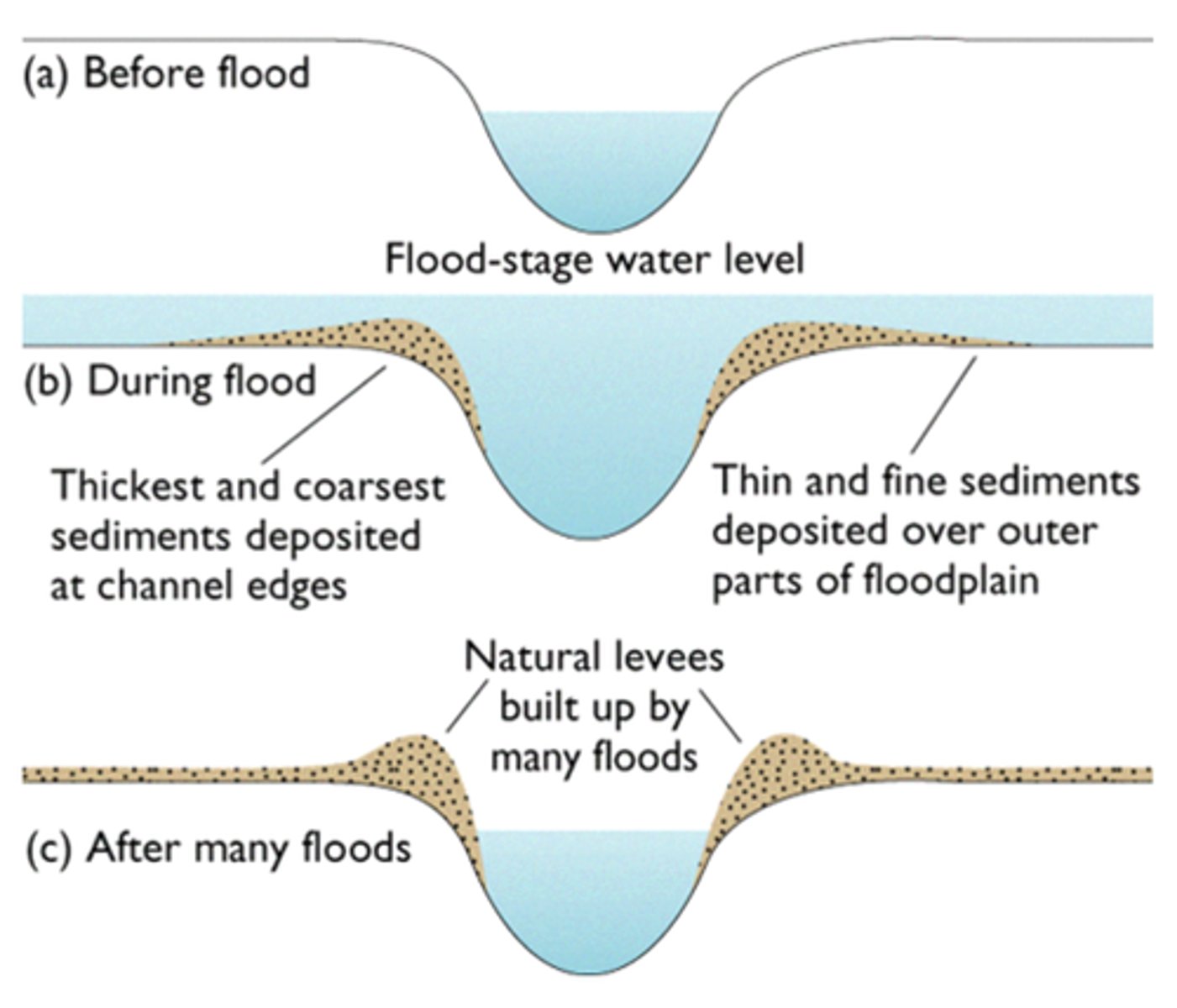
issues with levees
overtopping
seepage through/under the levee
not protection—postponement
The lower the pressure anomaly:
the greater the hurricane
Geostrophic balance neglects
friction
→ friction is working in opp direction, reducing wind speed therefore reducing the coriolis force. Low pressure spiraling inward, high spiraling outward
Topography
Mountains and buildings have an influence on winds.
Katabatic Winds
Colder air mass flows down ice and snow slops out to the water
Very fast winds
Move down a slope
Valley breeze
The movement of air created by warm air rising and flowing up the slope of a mountain.

What does surplus radiation at the equator imply?
poleward heat transport
Latitudinal heat transport is mainly driven by
the atmosphere at mid and high latitudes
intertropical convergence
Lots of rain because of ascending air
Rising warm air creates rainfall
dry spots
areas of cool air down currents
parcels of air moving north have lost moisture content from dumping it in other areas
Hadley cells
steady conveyor belt pushing energy north

Turbulent eddies
chaotic and random but have a net effect of pushing wind north.
arctic amplification
Poles warm more rapidly compared to the equator, reducing the latitudinal temperature gradient
Positive feedback loop of melting snow and ice isn't a solid explanation
atmospheric jets
Poles warm more rapidly compared to the equator, reducing the latitudinal temperature gradient
implications for weather extremes
Reduced meridional temperature gradient > reduced baroclinic eddy formation > reduced storm activity and temperature extremes
Reduced meridional temperature gradient > polar jet slows down > polar jet becomes more undulating --> more frequent and persistent storm activity and temperature extremes
Easterlies blow...
from the east
The albedo of a surface is:
the % of radiation reflected by a surface
Why is the North Pole cooler than the equator during the summer, even though there are 24 hours of daylight per day?
the sun is lower above the horizon at the north pole than at the equator
The amount of incoming solar radiation absorbed by the earth system is equal to:
The amount of infrared radiation emitted by the Earth system.
Summers are warmer than winters because:
The sun is higher in the sky and the days are longer in the summer, due to the tilt of the Earth
The seasons are due to:
The tilt of earth as it orbits
Earth only absorbs solar radiation during daytime, whereas it emits infrared radiation:
day and night
Saturation water vapor pressure
Measures the maximum amount of water vapor that a given volume of air can contain